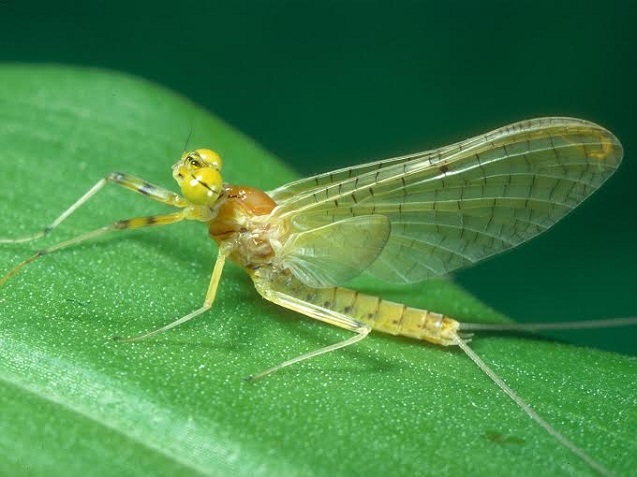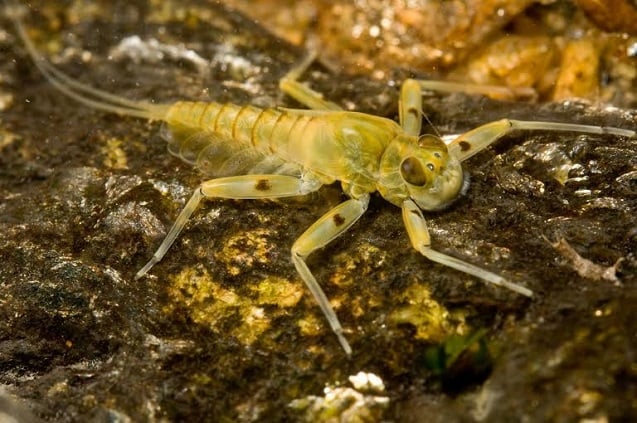
A study by Pennsylvania-based Stroud Water Research Center found that even highly-diluted levels of fracking wastewater could have a deadly effect on an insect known for its fragile beauty and long-considered a key indicator of stream health.
The study, funded by the Delaware River Basin Commission, found that a sample of wastewater produced during hydraulic fracturing in Pennsylvania had a devastating effect on mayflies. It raises questions about potential impacts to fish, stream invertebrates, birds and humans living near unconventional oil and gas activity and the possibility of long-term degradation of marine environments from hydraulic fracturing (also called fracking).
“Mayflies represent stream quality, and if the stream quality isn’t good in an ecosystem, what are the impacts to the fish and bigger animals . . . to the people?” Vanessa Lamers, an environmental scientist who spent a year studying the impacts of fracking on water in Washington County, Penn., told Truthout.
In a laboratory setting, entomologist and lead researcher John K. Jackson and two other Stroud scientists exposed three species of mayflies to both clean water from pristine streams and varying levels of wastewater diluted with clean water.
Researchers concluded that sodium chloride from wastewater proved deadly to mayflies – even when the wastewater was diluted to small amounts.
Wastewater diluted down to 2 percent killed half of all three species of mayflies in a 48-hour exposure period.
“That’s significant,” said Jackson, a Stroud senior research scientist. “For example, in a small stream, it won’t take much produced water entering the stream for mayflies to die or otherwise show signs of stress, which together could result in measurable changes in stream invertebrates and fish.”
Over a longer duration, the mayflies fared worse. Half the mayflies of all three species died after 20- to 30-day exposures to concentrations of less than 0.5 percent produced wastewater, Jackson said. Nonlethal effects were consistently observed even at concentrations near 0.25 percent.
Among the mayflies that survived to reach the adult stage, development time slowed, indicating they were stressed, according to the study.
During the Stroud study, sodium chloride, also known as common salt, proved to be the deadly chemical in the wastewater, according to Jackson. The study found that the sample of produced wastewater had more than four times the sodium chloride (NaCl) of seawater.”
Ecologists and environmentalists who watch the industry, from Pennsylvania’s Marcellus Shale to North Dakota’s Bakken formation, have raised alarms about how wastewater is transported, where it ends up and potential environmental and health impacts from radioactive materials, toxic compounds and salts. Experts who reviewed results of the Stroud study told Truthout.org that the results were troubling and more research of this kind was needed.
While environmentalists and many residents worry about arsenic, barium or radium – a radioactive element loosened during the fracking process – in wastewater, the study was a reminder that fracking brines and fluids contain many different elements.
“Sometimes the things that can be most harmful come from the things that might not seem as bad,” Lamers said.
Toxic salt
Mayflies, which range from a half-inch to an inch in length, are an ancient order of insects that spend most of their life as larva in the water. Known for their fragile beauty and short lifespan as an adult, the mayfly is famous in the fly-fishing world.
 Mayfly larva. (Photo: Dave Funk, Stroud Water Resource Center)
Mayfly larva. (Photo: Dave Funk, Stroud Water Resource Center)
Most mayflies lay their eggs immediately after mating; the eggs then take anywhere from 10 days to many months to hatch. These insects need clean water to live in, and scientists look for their larva in water to see if the water is polluted.
The Stroud study was concluded in August, 2013. The sample of untreated wastewater used in the study was obtained by the Delaware River Basin Commission and taken from a treatment facility in Pennsylvania, Jackson said.
Sodium chloride, also known as common salt, proved to be the deadly chemical in the wastewater, according to Jackson. The study found that the sample of produced wastewater had more than four times the sodium chloride (NaCl) of seawater.
To prove the sodium chloride was causing the mortality, scientists exposed the mayflies to a sodium chloride and water mixture and discovered that the insects reacted in the same way they did to the wastewater. “The toxicity of produced water was very similar to the toxicity of the sodium chloride test,” Jackson said.
The big problem is that sodium chloride – in high levels – is a common element in fracking wastewater in Marcellus Shale and other shale regions, said Meghan Betcher, a staff scientist with Downstream Strategies who was part of a team that attempted last year to track wastewater at several wells in Pennsylvania and West Virginia.
Traditional filtration processes do a poor job of filtering dissolved sodium chloride; distillation, an energy-intensive and expensive process, must be used, Sandra Steingraber, an environmentalist and ecologist in residence at Ithaca College, told Truthout.
The mayfly is considered a keystone species for aquatic ecosystems, said Steingraber. Mayflies hatching in spring and summer can trigger a frenzy feeding in trout and other insect-eaters such as birds and dragonflies.
“Their hatching provides the basis for the whole food chain,” Steingraber said. “This is a study that would certainly make a trout fisher stand up and pay attention.”
Elevated sodium chloride levels in surface waters isn’t bad for mayflies only. It could have impacts on people in the United States who get drinking water from lakes, rivers and other surface water supplies near areas with hydraulic fracturing, Steingraber said. “We know it’s not good for people to drink water with elevated sodium chloride in it,” the ecologist told Truthout. Roughly 60 percent of the US population gets its drinking water from surface water sources.
Lamers agrees the study raises additional concerns about human health impacts. “In Pennsylvania, most public drinking water typically comes from surface water sources, such as the Delaware River Basin or Allegany River,” the scientist said. While that water is filtered, research has proven that public water filtration plants cannot remove some of the contaminants in fracking wastewater, Lamers told Truthout.
A Reliable Indicator
Jackson acknowledged the scope of the mayfly study was limited. The study used only one sample of wastewater – taken from a truck containing produced wastewater at a treatment facility undisclosed to the Stroud researchers.
But a negative impact on mayflies could be seen as a harbinger of ecological strain. These insects are sensitive to changes in water chemistry, temperature and other environmental variables.
“Mayflies are a very reliable indicator of whether a stream is healthy or not healthy,” saidJackson. “When it comes to streams, we want to see vibrant communities of mayfly species there.”
While mayflies are a valuable species for evaluating water quality, they are not widely used outside of Stroud Water Research Center. Collecting and rearing enough at the same life stages for lab studies is difficult. In the 1980s and 1990s, however, Stroud center scientists developed a method of producing large numbers of mayflies for research studies.
Dirty Water
It’s exceedingly difficult to track wastewater produced in regions with hydraulic fracturing for oil and gas.
“There is just a lot of movement of wastewater,” Betcher, the environmental scientist with Downstream Strategies, said. “A lot of movement of dirty water.”
Up to 35 percent of fracking water – or about 1.75 million gallons at the higher range – can return to the surface, according to a study by the N.C. Department of Environment and Natural Resources.
Steingraber points to a three-tanker truck crash last month in Washington County, Penn., as an incident that is even more worrisome considering the potential impacts of wastewater on mayflies. The crash required a cleanup effort to soak up 1,300 gallons of spilled diesel fuel. Another, perhaps even more significant, concern was 400 gallons of fracking wastewater that spilled from two of the trucks carrying frackwater.
But industry oil and gas officials contend that new industry best practices, such as piping wastewater through a closed system of pipes and storage tanks – instead of using open impoundment ponds – and recycling and reusing wastewater in oil and gas wells, will reduce the chances of spills or seepage of wastewater. Industry officials say recycling – as opposed to trucking wastewater to deep injection wells in Ohio – cuts down on truck trips.
“Most of the major companies are recycling wastewater,” Dan Weaver, director of public outreach for The Pennsylvania Independent Oil and Gas Association (PIOGA), told Truthout.
For Steingraber, the use of a closed storage system raises more questions than answers. “When a truck crashes, you know it immediately,” he said. “Would the same be true of a water line? Or could accidents/leaks actually be much more? Who is monitoring water lines? How are they regulated? How are accidents reported? On whose property do they run? Does the industry offer any supportive scientific documentation for leakage rates and accidents?”
The new industry best practice of recycling wastewater also does little to alleviate concerns about wastewater. “The more water you recycle, the more sludge you get and the more toxic it is,” Steingraber said. “Recycling makes nothing go away. So, this whole recycling thing is a kind of shell game.”
Needed Research
Fish or other aquatic life could also be susceptible to chloride, or to other compounds or chemicals commonly associated with wastewater. “Although chloride impacts mayflies, other chemicals in wastewater could impact fish,” Steingraber added.
Lamers said the Stroud mayfly study is important work. “This kind of research is needed,” she said. It confirms early research on fracking that dates back to 2011. A report published in the journal Risk Analysis found that “the potential contamination risk and epistemic uncertainty associated with hydraulic fracturing wastewater disposal was several orders of magnitude larger than the other pathways” such as well-casing leaks and drilling-site discharge.
Lamers said one solution is to classify fracking wastewater as hazardous waste, which it currently is not because of federal exemptions granted to the industry.
Erosion is another, separate issue that has been impacting streams and rivers.
“If you put an oil rig up on a big hill, and if you are not controlling that erosion, you are going to bury that stream,” Lamers said. “You are going to disrupt the system. It is one of the biggest problems.”
Join us in defending the truth before it’s too late
The future of independent journalism is uncertain, and the consequences of losing it are too grave to ignore. To ensure Truthout remains safe, strong, and free, we need to raise $50,000 in the next 9 days. Every dollar raised goes directly toward the costs of producing news you can trust.
Please give what you can — because by supporting us with a tax-deductible donation, you’re not just preserving a source of news, you’re helping to safeguard what’s left of our democracy.